Why PPE Should Be the Last Line of Defence Against Dust Exposure!
Reimagining Workplace Safety for a Healthier Future

Dust can be an insidious hazard in workplaces ranging from bustling construction sites to high-tech manufacturing floors. In the battle against airborne particulates, it may be tempting to rely solely on Personal Protective Equipment (PPE): face masks, respirators, safety goggles. Yet, while PPE undeniably plays a vital role, it should never be the first, nor the only, shield we raise against dust exposure.
The Problem with Relying on PPE Alone
PPE is often viewed as a straightforward solution to complex safety challenges. Slip on a mask, don some goggles, and the problem goes away, or so it seems. But this approach is fundamentally flawed. PPE, by its very nature, is a reactive measure. It addresses hazardous exposure only after it occurs, rather than preventing it in the first place.
Moreover, PPE depends on human behaviour, proper selection, fit, maintenance, and consistent use. One moment of neglect or a poorly fitted mask can render protection moot. Relying on PPE alone shifts responsibility to the individual, overlooking the potential for systemic improvements in the work environment.
A Hierarchy of Controls: Rethinking Risk Management
Safety professionals advocate for the hierarchy of controls, a tiered framework for minimising occupational hazards. At the top are measures that eliminate danger at its source:
• Elimination: Remove the hazardous material altogether.
• Substitution: Replace dangerous substances with safer alternatives.
• Engineering Controls: Isolate people from hazards using ventilation systems, enclosed processes, or barriers.
• Administrative Controls: Change the way people work, scheduling, training, signage in order to reduce risk.
• PPE: Equip workers with personal protective equipment.
PPE thus sits at the base of this pyramid, meant to supplement, not substitute, more robust interventions.
Engineering Solutions: Where Prevention Begins
Foaming dust suppression systems, dust extraction units, and enclosure of dust-generating machinery are all examples of engineering controls that can drastically reduce dust levels before workers are ever exposed. These systems, when properly designed and maintained, offer continuous protection, reducing human error or forgetfulness.
Administrative Controls: Enhancing Safe Practices
Dust Risk Management Procedures
• Provide comprehensive induction and ongoing training to ensure all staff are informed of dust risks and appropriate management strategies.
• Display clear warning signage around plant facilities and in common areas to alert personnel to potential hazards.
• Implement worker rotation schedules and restrict time spent in dust-exposed environments to minimise risk.
• Establish maintenance protocols that require plant wash-downs before commencing work.
• Uphold cleanliness standards at worksites and offices through regular cleaning routines, dusting, and minimizing the transfer of dust via clothing and footwear.
• Conduct pre-start inspections focusing on cabin cleanliness, door and window seals, and the condition and cleanliness of air conditioners, including filter checks.
• Communicate the results of dust monitoring clearly to all relevant staff.
• If air cleaners require servicing, develop procedures to protect workers from dust inhalation during filter cleaning, or outsource this task to reputable service providers.
• Ensure easily accessible personal protective equipment (PPE) is available for all staff members.
• Train employees on the correct selection, use, and fitting of PPE suitable for specific tasks.
• Maintain all PPE regularly to guarantee it remains effective and in proper working order.
When PPE is Essential
Despite best efforts, some dust exposure risks may remain. Here, PPE becomes indispensable, a last barrier when all other controls are impractical or insufficient. Even then, regular fit-testing, user training, and equipment maintenance are vital to ensure PPE’s effectiveness.
The Path Forward: Prevention First, Protection Second
A truly safe workplace doesn't begin with a mask, but with a mindset: prevention is paramount. By prioritising elimination, substitution, and engineering controls, we can create environments where PPE is a backup, not a lifeline.
In the end, recognising PPE as the last line of defence is not a denial of its importance, but a call to action. Let us innovate, invest, and educate. Protect workers not just with equipment, but with environments that are safer by design. Dust may be a persistent foe, but with foresight and commitment, it is a challenge we are ready to meet.

